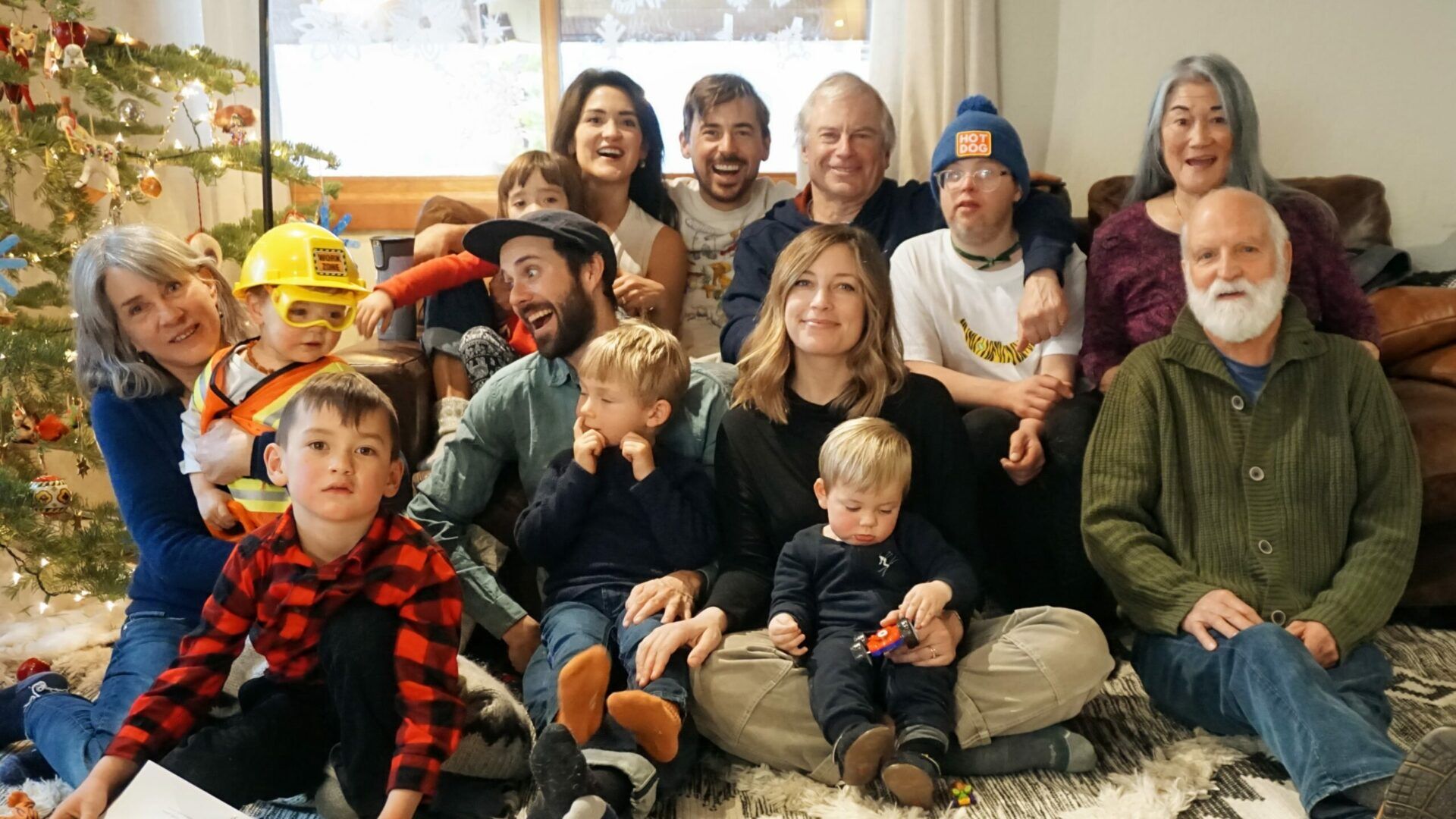For kids, the holidays are a time of wonder and excitement. You get a break from school, there are special treats, travel, overnight visitors, events, parties, crafts, decorations, and of course… PRESENTS! As a parent who’s responsible for organizing all of the above – the wonder and excitement can be eclipsed by a feeling of overwhelming pressure.
Last year, our family hosted Christmas morning with all family members from 4 different households. There was homemade brunch, presents, decorations, music… the works! It was 4 hours of present-opening that eventually devolved into a sea of wrapping paper and forgotten gifts. It was successful, but I was glad it was over.

In the hustle and bustle of the holidays, we’d forgotten to plan for what came afterwards. Four days later, my youngest child turned 2… and we forgot to get him a birthday present. His “birthday cake” was cinnamon rolls made from leftover challah dough. My husband and I both have December birthdays, so we of all people should know better than to smush Christmas and a birthday together. Of course, he was young enough that he didn’t notice the oversight.


This year, I want to do better. I want to properly celebrate my baby’s birthday. I want my kids to show appreciation for each Christmas gift. I want to focus on the activities we really love, and cut out the extra noise. This year, I’m approaching the holidays as a project to be managed, rather than a turbulent sea of unmet expectations.
Doing anything with children is typically more difficult than just taking care of it alone – but getting their help on selected activities can actually make the holidays better for everyone. So after a lot of research and planning, we’ve created a Surviving The Holidays workbook that can help your family tackle the season with a plan for success. Even if your child is too young to read and write, you can transcribe their answers and have them draw pictures. As long as they get involved, it’s a win!
Download the entire Surviving The Holidays workbook here, and continue reading to see how to tackle the holidays without stress.

1. Create a [very limited] wish list
Using the Wish List page, I sat down with each of my kids to compile their own wish list – an event they relished with gusto.

The trick is to limit the number of things they can add. If they list every single thing they want, disappointment is inevitable. But when there’s only space for 5 items, they prioritize what they desire most. I also created categories of presents, so they can imagine gifts beyond the latest must-have Lego set. Here are the types of gifts they added to their wishlists:
- Something they want
- Something the need
- Something they wear
- Something they need
- And: Something they will give.
You may recognize the “Want / Need / Wear / Read” list items. It’s a great formula to ensure that your child doesn’t think ONLY of toys and treats, but sees that other types of gifts are desirable too. If your child first realizes that they need new socks, they’ll be a more grateful to receive them. The last element “Give” I threw in to get my kids to start considering what they can give to another person. It’s a small gesture that will prime them to start thinking more generously.
Now, when grandparents ask what the kids want for Christmas, I send them a picture of their wish list. Or I can share my child’s shop in Ketshop, which features parent-approved items that they can buy as gifts. Telling others what you want might feel awkward, but people appreciate hints! Giving direction to Grandma helps her choose something kids will love… and lets me control what types of items enter our home.
2. Reflect on past behavior… both naughty and nice.
My Christmas wish (we’re dreaming big here) is to have kids who listen and respect boundaries. This is a year-round goal, but during the holidays I especially need the kids to be on the same team. The best way to get a behavioral change is to include the child in creating a solution.
On the Naughty & Nice page, we reflect on past behavior – celebrating our virtues, and admitting the naughty things we’ve done. When we create a plan to do better, we are less likely to make the same transgressions over and over. Every family member completes this exercise: when kids see that even adults make mistakes, it becomes easier to admit their own faults. This is a great activity for the end of the year as we think about New Year’s Resolutions. It helps us appreciate what others have done for us, and create a plan for our own improvement.
3. Create a family task list… and let go
There’s always one person in the family who is the Holiday Boss. (For a lot of families, its Mom.) Maybe Dad helps with hanging Christmas lights or putting up the tree. But whoever is Holiday Boss is figuring out what presents to buy, wrapping them, decorating, meal planning, travel planning, managing various holiday invitations, planning matching pajama photos, sending out holiday cards, coordinating with relatives… and much more.
That’s a lot to add to any parent’s already-busy list of responsibilities. When I’m deep in holiday-mode, I don’t realize how much I’ve taken on. (Newsflash: we don’t have to do every single thing every single year! It’s ok to skip a tradition for a year, it won’t ruin your family.)
To prevent burnout, focus on the most important things. Make a list of all must-do items, and those that are nice bonuses. Don’t forget to include non-holiday tasks, like childcare and laundry. Then, use the Surviving The Holidays: Task List page to divide everything up based on who has corresponding skills and bandwidth.
To make this division of labor successful, you have relinquish control. This can be tough for Holiday Boss. Initially, you might demonstrate how to complete a task, but then hand over the reigns. If you really care how the house is decorated, then do it yourself. But if your spouse has agreed to do it, let them do it their way – without correction. It’s not your job, and nobody wants a micro-manager.

Please don’t forget to give your children some responsibilities too! Participation in holiday chores helps them appreciate all that goes into these events, and shows them that they’re an important part of the family. Younger children can “help” a parent with chores, while older kids can complete tasks solo. Great chores for kids include:
- Helping decorate the house
- Wrapping presents
- Helping cook family meals
- Signing holiday cards
- Vacuuming and/or sweeping before guests arrive
- Recycling wrapping paper after gift exchanges
- Packing away decorations after the holidays
Don’t be afraid to give your family challenging assignments. Holiday chores are often more fun than everyday ones, and working on a project together can be a joyful experience.
4. Create your gift list
One of my favorite parts of Christmas is seeing a loved one open my present. Sometimes, you get more pleasure from giving than receiving. This enthusiasm isn’t learned – it’s innate. Children can’t wait for their friend to open their gift. By encouraging your kids to help choose and wrap presents for loved ones, you can double the joy.
To make sure you didn’t forget anyone, use the Gift List page to make a list of all the family members, along with appropriate gift ideas. This is more of a brainstorm – if your child thinks Nana wants a unicorn, write it down. Don’t worry about practicality for now. As you begin to check off gifts, note about how much money each item cost. Although tracking costs might feel awkward, it’s helpful to keep tabs on how much you spend. Moreover, it’s impactful for your child to see the cost and consideration that goes into every gift.
5. Make a giving plan
The holidays aren’t just about presents, they’re also about generosity and spreading good will. You might already donate to shelters, charities, and non-profits during this time of the year. But these types of donations are invisible to your children.
We sat down with our kids and figured out which causes matter to them. The Surviving The Holidays workbook’s Giving Plan page offers a few categories to consider:
- Environment
- Poverty
- Animal Welfare
- Education
- Social Justice
Once your child has identified 1-2 topics they care about, help them research organizations that are addressing their issue. Together, create a plan to get involved, whether it’s making a financial donation or volunteering. I encourage my children to donate a portion of their own money, no matter how small: sacrificing $1 of your own money feels much bigger than giving $100 of someone else’s. The pride my kids feel when they donate makes me incredibly proud. It’s a virtuous cycle.
5. Finally, create a family holiday plan
Before the whirlwind of holiday parties begins, make a plan with your partner or family. What matters most to your family? Togetherness? Traditions? Religion? Write it down on the Holiday Plan page. Every family is different, and it’s important to give thought to these bigger questions.
Defining your values will help your family determine what activities are important, and which you can skip if you’re feeling overwhelmed. For example, if you decide that the most important thing is being present with your kids on Christmas morning, maybe you shouldn’t plan to host an elaborate party that starts at noon.
Inevitably, there will be more activities than you can handle. Take a peek at your schedules ahead of time and determine which things you will do together (like Christmas Eve at Aunt Betty’s) and which you will divide and conquer (drop the kids off at a holiday craft party, then shop for stocking stuffers).
Finally, the holidays always throw off your routines. Figure out which boundaries matter to your family, and which ones can be tweaked for special occasions. In our family, we allow more treats during the holidays and will push bedtime back by an hour or so. Those are our flexible boundaries. Our firm boundaries are getting regular exercise and eating healthy meals.
Once you’ve created a family holiday plan, it’s clear what fits into your life and what feels unnecessary.






